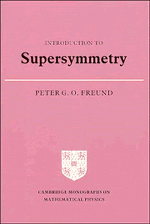Book contents
- Frontmatter
- Contents
- Preface
- I Supersymmetry: the physical and mathematical foundations
- II Globally supersymmetric theories
- III Supergravities: locally supersymmetric theories
- 20 The problem of gauging supersymmetry
- 21 Einstein gravity as a gauge theory
- 22 N = 1 supergravity
- 23 Extended supergravities
- 24 The hidden assumptions of grand unification and the matter/force problem
- 25 Higher-dimensional unification
- 26 Eleven-dimensional supergravity and its preferential compactification
- IV Conclusion
- References
- Index
24 - The hidden assumptions of grand unification and the matter/force problem
Published online by Cambridge University Press: 01 June 2011
- Frontmatter
- Contents
- Preface
- I Supersymmetry: the physical and mathematical foundations
- II Globally supersymmetric theories
- III Supergravities: locally supersymmetric theories
- 20 The problem of gauging supersymmetry
- 21 Einstein gravity as a gauge theory
- 22 N = 1 supergravity
- 23 Extended supergravities
- 24 The hidden assumptions of grand unification and the matter/force problem
- 25 Higher-dimensional unification
- 26 Eleven-dimensional supergravity and its preferential compactification
- IV Conclusion
- References
- Index
Summary
There are some features of N = 8 supergravity, shared, as we shall see, with higher-dimensional supergravities, that make these theories so very attractive. First of all, there are some assumptions in both ordinary and supersymmetric grand unification, so well hidden, that it is usually glossed over that they even are assumptions. Any grand unification starts by naming the grand unifying compact simple gauge group G(SU(5), SO(10)…). Now a clever guess concerning G goes a long way, but the list of simple compact Lie groups is infinite (Cartan 1894), and in theoretical physics a specific choice of G out of this infinite list ought to be theoretically justified. In ordinary grand unification no ideas for such a theoretical justification of the gauge group are ever alluded to. In extended (N = 8) supergravity we have seen that the choice of G is quite limited: SO(8) × SU/(8) or some subgroup thereof as chosen by the extrema of the potential. Once G is chosen, the gauge bosons are uniquely specified, but grand unification again refers to inspired guesses when it comes to the assignment of the matter (spin one-half fermions + Higgs scalars) to specific G-multiplets. Again these assignments, modulo all the difficulties mentioned in chapter 23, are theoretically dictated in N = 8 supergravity.
- Type
- Chapter
- Information
- Introduction to Supersymmetry , pp. 117 - 119Publisher: Cambridge University PressPrint publication year: 1986

